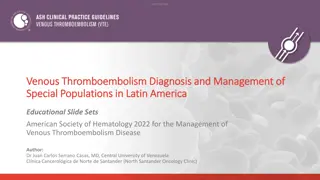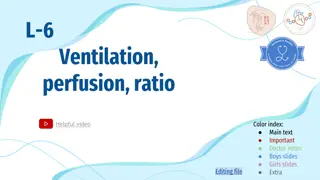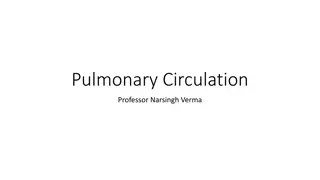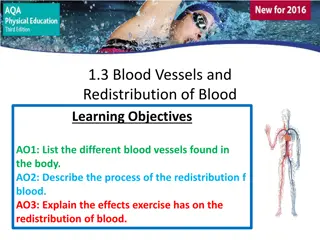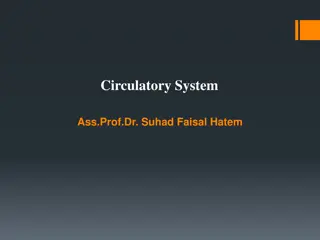Venous Thromboembolism in the Context of Pregnancy
Key guidelines from the American Society of Hematology (ASH) in 2018 focus on managing venous thromboembolism in pregnancy. The guidelines cover prevention, treatment, and optimal management of VTE in various clinical settings. Panels formed for guideline development included diverse expertise to en
1 views • 49 slides
EURAXESS Talent Circulation Hub
The EURAXESS Talent Circulation Hub focuses on mobility support for researchers in the ERA, aiming to attract, welcome, integrate, and retain talent. Its structured core coordination group engages with the wider EURAXESS community to enhance services related to international mobility, alumni engagem
4 views • 13 slides
Venous Thromboembolism Diagnosis and Management in Latin America: ASH 2022 Educational Slide Sets
The American Society of Hematology (ASH) 2022 guidelines for the diagnosis and management of venous thromboembolism in special populations in Latin America are presented in educational slide sets authored by Dr. Juan Carlos Serrano Casas and other experts. The Latin American ADOLOPMENT project, a co
0 views • 52 slides
Understanding Deep Ocean Circulation and Salinity Patterns
Explore the intricate relationship between ocean salinity, vertical structure, and deep-water currents in this informative collection of images and explanations. Discover how salt inputs and outputs influence ocean salinity levels, and learn about the factors that contribute to the vertical variatio
12 views • 21 slides
Central Venous Catheter Access Management in Brampton and Surrounding Areas
Nurse-led Outreach Team in Brampton, North Etobicoke, West Woodbridge, Malton, and Bramalea provides education on managing central venous catheter access devices like PICCs. Learn about preventing infections, post-insertion care, types of CVADs, and aseptic techniques for PICC line management.
1 views • 20 slides
Understanding Pulmonary Circulation and V/Q Ratio in Respiratory Physiology
Explore the high-pressure and low-pressure circulations supplying the lungs, the concept of physiological shunt in pulmonary circulation, different lung zones based on blood flow, V/Q ratio and its clinical significance, and abnormal V/Q ratio patterns. Delve into the role of pulmonary circulations
11 views • 28 slides
Understanding Central Venous Line (CVL) and Central Venous Pressure (CVP) Monitoring
Central Venous Line (CVL) and Central Venous Pressure (CVP) monitoring play critical roles in intensive care settings. This article covers the indications, types, insertion sites, and contraindications of CVL. It also explains the significance of CVP measurement and how to perform and interpret it u
3 views • 40 slides
Venous Thromboembolism Market
Venous thromboembolism occurs when a blood clot forms in a vein, obstructing the blood flow and posing a potentially life-threatening risk. Several devices and drugs are employed for the prevention and treatment of venous thromboembolism. The devices considered within this scope are utilized for bot
5 views • 3 slides
Guidelines for Thrombophilia Testing in Venous Thromboembolism Management
The American Society of Hematology (ASH) provides comprehensive guidelines for the management of venous thromboembolism (VTE) with a focus on thrombophilia testing. Expert panels develop recommendations based on clinical questions, evidence synthesis, and resource use. These guidelines cover various
2 views • 47 slides
Circulation/ILL Advisory Group Overview and Manual Item Recovery Discussion
The Circulation/ILL Advisory Group plays a crucial role in consulting with CCS on system changes, conducting research, and recommending policy improvements. Advisory group members are expected to actively participate in meetings, engage in discussions, and collaborate with CCS staff. Additionally, t
0 views • 21 slides
ASH Guidelines 2020: Management of Venous Thromboembolism
American Society of Hematology (ASH) released guidelines in 2020 for the management of Venous Thromboembolism, focusing on deep vein thrombosis and pulmonary embolism. These guidelines cover prevention, treatment, and optimal management strategies. The recommendations are developed through a rigorou
0 views • 45 slides
Understanding Pulmonary Circulation and Its Importance in Respiratory Physiology
Pulmonary circulation, as explained by Professor Narsingh Verma, plays a crucial role in the respiratory system, showcasing distinct differences from systemic circulation. The low pressure and resistance in pulmonary circulation allow for optimal gas exchange at the alveolocapillary membrane. Variou
1 views • 30 slides
Understanding Blood Vessels and Circulation in the Body
Explore the intricate network of blood vessels in the body, including arteries, veins, and capillaries. Learn about the process of blood redistribution and the impact of exercise on circulation. Understand the vital role of the circulatory system in maintaining overall health and physical performanc
0 views • 14 slides
Understanding Cardiac Output and Venous Return in Cardiovascular Physiology
Cardiac output, stroke volume, end-diastolic and end-systolic volumes play vital roles in cardiovascular function. Factors affecting cardiac output include physiological conditions and pathological states like hyperthyroidism and myocardial infarction. Venous return, controlled by mechanisms like Fr
0 views • 27 slides
Understanding Cerebrospinal Fluid (CSF): Functions, Formation, and Circulation
Cerebrospinal fluid (CSF) plays a vital role in providing a controlled chemical environment, nutrient supply, waste removal, and physical support and protection to the brain and spinal cord. This fluid circulates around the central nervous system, and its formation involves processes like selective
0 views • 23 slides
ASH Guidelines on Venous Thromboembolism in Pregnancy
The American Society of Hematology (ASH) 2018 guidelines provide comprehensive management recommendations for venous thromboembolism in pregnancy. Key aspects include panel formation, clinical questions generation, evidence synthesis, and making recommendations. The guidelines offer strong and condi
0 views • 49 slides
Understanding Coronary Circulation and Arterial Supply in Cardiovascular Physiology
Explore the intricate details of coronary circulation, including arterial supply, branches of coronary arteries, and areas of distribution. Dr. Abeer Al-Masri, an Associate Professor and Cardiovascular Physiologist at the Faculty of Medicine, KSU, provides valuable insights on the topic, covering th
1 views • 30 slides
Understanding the Cardiovascular System: An In-Depth Exploration
Exploring the intricate workings of the cardiovascular system, this comprehensive guide covers the heart, blood vessels, circulation, and the composition of blood. Learn about the structure and functions of the heart chambers, blood vessels, and the vital role of blood in maintaining circulation. De
2 views • 16 slides
Understanding the Intrinsic Muscles of the Tongue - Anatomy and Physiology Overview
In this detailed presentation by Dr. Sushma Tomar, Associate Professor of Anatomy, the intrinsic muscles of the tongue are explored, along with their functions, arterial and venous supply, lymphatic drainage, and nerve supply. The lecture covers the four intrinsic muscles in each half of the tongue,
1 views • 15 slides
Plant Mineral Nutrition: Absorption and Circulation of Ions in Roots
Plant mineral nutrition involves the absorption and translocation of ions across roots. Salts are absorbed passively and actively, with ions moving into the root's apoplasm via free diffusion. The Casparian strip in endodermal cells acts as a barrier, allowing ions to pass only through the protoplas
0 views • 27 slides
Understanding Cutaneous Circulation and Blood Supply in Different Body Regions
Cutaneous circulation plays a vital role in supplying blood to the skin, with variations in apical and non-apical regions of the body. The blood flow is regulated by neural, thermal, and metabolic factors, and controlled by sympathetic fibers. Sympathetic vasoconstriction and vasodilation affect the
0 views • 19 slides
Guidelines for Management of Pediatric Venous Thromboembolism
This educational slide set presents the American Society of Hematology's 2018 guidelines for the treatment of pediatric venous thromboembolism. The guidelines cover various aspects such as prevention, treatment, and optimal management of anticoagulation therapy in pediatric patients. Panels were for
0 views • 47 slides
Understanding Capillary Circulation in the Vascular System
This content delves into the intricate components of capillary circulation, covering topics such as microcirculation, types of capillaries, regulation of flow in capillary beds, and the formation of interstitial fluid. It also discusses edema, lymphatics, diffusion, and filtration processes. The vis
4 views • 28 slides
Overview of Veins and Venous Circulation in the Body
Veins play a crucial role in the circulatory system by carrying deoxygenated blood back to the heart. This lecture covers the general principles of veins, the anatomy of major veins like the superior and inferior vena cavae, tributaries, and their roles in different parts of the body. It also discus
0 views • 14 slides
New Invenio Circulation Module Demo - Requirements and Workflow Proposal
Introduction to the new Invenio Circulation module demo and its requirements for managing books, documents, and acquisitions. Explore the circulation system's user and librarian views, including search capabilities, loan processes, and item management. Key features include integration of holdings in
0 views • 20 slides
Central Venous Catheters: Uses, Placement, and Indications
A central venous catheter (CVC) is a crucial medical device placed into a large vein for various purposes like administering medication, fluids, and obtaining blood tests. The catheter can be tunneled or non-tunneled, and specific sites are preferred for each type. Indications for CVC usage include
1 views • 19 slides
Venous Blood Collection Methods and Equipment Overview
Venous blood collection techniques, including antecubital fossa and heel sticks, are commonly used for laboratory examinations. Venous blood is preferred for its large volume and ease of recovery. This article also explores the differences between capillary and venous blood samples in terms of compo
0 views • 8 slides
Understanding the Circulatory System: Functions and Components
The circulatory system, comprised of pulmonary and systemic circulation, plays a crucial role in transporting oxygen, nutrients, and waste products throughout the body. It consists of the heart, arteries, veins, and capillaries which work together to ensure proper circulation. Blood, the carrier of
0 views • 21 slides
Animal Circulation and Gas Exchange Systems Overview
The lecture explores the importance of circulation and gas exchange systems in animals, covering topics such as the evolution of double circulation, blood structure and function, respiratory pigments, and the necessity of oxygen acquisition and carbon dioxide release in diverse animal species. It al
0 views • 127 slides
Understanding Venous Needle Dislodgement in Dialysis Patients
Venous Needle Dislodgement (VND) is a serious complication of hemodialysis that can lead to significant blood loss and even mortality. It occurs when the venous fistula needle becomes dislocated, resulting in blood loss ranging from minor to fatal. The risk factors, consequences, and frequency of VN
0 views • 30 slides
Understanding Atmospheric Circulation and Wind Patterns
Learn about atmospheric circulation, local winds, terrain types, mean velocity profiles, and different types of winds such as prevailing winds, periodic winds, and local winds. Explore the concept of planetary winds like Trade Winds and Westerly Winds, and understand how winds create air currents. D
0 views • 22 slides
Understanding Atmospheric Circulation on Earth
An atmospheric circulation driven by temperature differences between the equator and poles influences global weather patterns. The sun's changing angle throughout the year results in various pressure areas and the formation of large circulation cells. The main effects include the transport of humidi
0 views • 11 slides
Measurement Technique for Meridional Circulation in Solar Activity
In this research, time-distance measurements were conducted to study meridional circulation in solar activity. The east-west signal was found to be similar to the north-south signal, prompting analysis steps involving spherical harmonics computation, image reconstruction, filtering, cross-correlatio
0 views • 7 slides
Treatment Strategies for Recurrent Venous Thromboembolism in Factor V Leiden Patients
This presentation discusses the treatment options for recurrent venous thromboembolism in patients with Factor V Leiden mutation. It explores the pathophysiology, epidemiology, and diagnosis criteria for Factor V Leiden, reviews failed anticoagulation history, and suggests outpatient anticoagulation
0 views • 31 slides
Pediatric Surgery: Special Considerations for Venous Access and Fluid Management
Pediatric surgery requires special attention to venous access and fluid management due to unique considerations in infants and children. Key aspects include methods for obtaining vascular access, monitoring fluid and electrolyte balance, and addressing specific fluid requirements based on age and we
0 views • 15 slides
Understanding Embolism and Venous Thrombosis in Mechanism of Disease
Embolism, defined as a detached intravascular mass carried through the blood, poses serious risks like pulmonary embolism. Venous thrombosis, particularly deep vein thrombosis (DVT), can lead to embolization, emphasizing the importance of understanding these mechanisms in medical practice.
0 views • 40 slides
CCS Updates: Polaris Upgrade & Circulation Distribution Emails
Latest CCS updates include the scheduled upgrade of Polaris to version 7.5, enhancements to the distribution emails for circulation, a new functionality for damaged circulation status, and more. Staff are advised to check patron records for in-house use and utilize the Leap Find Tool for efficient s
0 views • 16 slides
American Society of Hematology 2021 Guidelines for Venous Thromboembolism in Cancer Patients
The American Society of Hematology (ASH) 2021 guidelines provide recommendations for preventing and treating venous thromboembolism (VTE) in cancer patients. The guidelines cover primary prophylaxis for hospitalized medical patients and those undergoing surgery, emphasizing the use of thromboprophyl
0 views • 23 slides
Evolution of Circulation Audit Bureaus and Verification Process in Media Industry
Circulation Audit Bureaus are industry-sponsored organizations that verify and report publication circulations. The history dates back to the late 1800s when they were established to address inflated circulation figures. The verification process involves audits and adherence to standards set by the
0 views • 50 slides
Deep Venous Disease Treatment Devices Market
The global deep venous disease treatment devices market was valued at $1,119.3 million in 2022 and is anticipated to reach $2,419.2 million by 2032, witnessing a CAGR of 7.72% during the forecast period 2023-2032.\n\nRead Report Overview: \/\/bisrese
1 views • 3 slides


